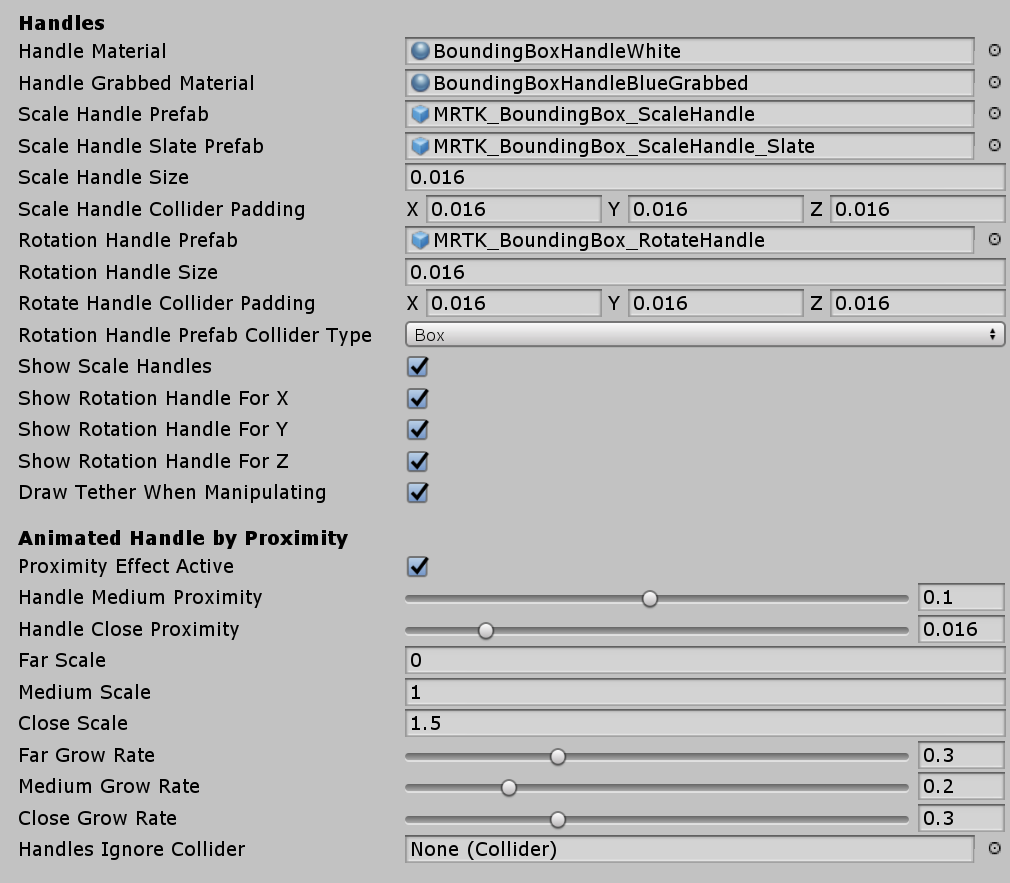Bounding box

The BoundingBox.cs script provides basic functionality for transforming objects in mixed reality. A bounding box will show a cube around the hologram to indicate that it can be interacted with. Handles on the corners and edges of the cube allow scaling or rotating the object. The bounding box also reacts to user input. On HoloLens 2 for example the bounding box responds to finger proximity, providing visual feedback to help perceive the distance from the object. All interactions and visuals can be easily customized.
For more information please see App Bar and Bounding Box on Windows Dev Center.
Example scene
You can find examples of Bounding Box configurations in the BoundingBoxExamples scene.

How to use a bounding box
To enable a bounding box around an object, simply assign the BoundingBox script to any GameObject. Note that the object will need a box collider, added in the Bounds Override field in the inspector.

Inspector properties
Target Object This property specifies which object will get transformed by the bounding box manipulation. If no object is set, the bounding box defaults to the owner object.
Bounds Override Sets a box collider from the object for bounds computation.
Activation Behavior There are several options to activate the bounding box interface.
- Activate On Start: Bounding Box becomes visible once the scene is started.
- Activate By Proximity: Bounding Box becomes visible when an articulated hand is close to the object.
- Activate By Pointer: Bounding Box becomes visible when it is targeted by a hand-ray pointer.
- Activate Manually: Bounding Box does not become visible automatically. You can manually activate it through a script by accessing the boundingBox.Active property.
Scale Minimum
The minimum allowed scale. This property is deprecated and it is preferable to add a TransformScaleHandler script. If this script is added, the minimum scale will be taken from it instead of from BoundingBox.
Scale Maximum
The maximum allowed scale. This property is deprecated and it is preferable to add a TransformScaleHandler script. If this script is added, the maximum scale will be taken from it instead of from BoundingBox.
Box Display Various bounding box visualization options.
If Flatten Axis is set to Flatten Auto, the script will disallow manipulation along the axis with the smallest extent. This results in a 2D bounding box, which is usually used for thin objects.
Handles You can assign the material and prefab to override the handle style. If no handles are assigned, they will be displayed in the default style.
Events
Bounding box provides the following events. The example uses these events to play audio feedback.
- Rotate Started: Fired when rotation starts.
- Rotate Ended: Fired when rotation ends.
- Scale Started: Fires when scaling ends.
- Scale Ended: Fires when scaling ends.

Bounding box handle styles
By default, when you just assign the BoundingBox.cs script, it will show the handle of the HoloLens 1st gen style. To use HoloLens 2 style handles, you need to assign proper handle prefabs and materials.

Below are the prefabs, materials, and the scaling values for the HoloLens 2 style Bounding Box handles. You can find this example in the BoundingBoxExamples scene.

Handles (Setup for HoloLens 2 style)
- Handle Material: BoundingBoxHandleWhite
- Handle Grabbed Material: BoundingBoxHandleBlueGrabbed
- Scale Handle Prefab: MRTK_BoundingBox_ScaleWidget
- Scale Handle Slate Prefab: MRTK_BoundingBox_ScaleWidget_Slate
- Scale Handle Size: 0.016 (1.6cm)
- Scale Handle Collider Padding: 0.016 (makes the grabbable collider slightly bigger than handle visual)
- Rotation Handle Prefab: MRTK_BoundingBox_RotateWidget
- Rotation Handle Size: 0.016
- Rotation Handle Collider Padding: 0.016 (makes the grabbable collider slightly bigger than handle visual)
Proximity (Setup for HoloLens 2 style)
Show and hide the handles with animation based on the distance to the hands. It has two-step scaling animation.

- Proximity Effect Active: Enable proximity-based handle activation
- Handle Medium Proximity: Distance for the 1st step scaling
- Handle Close Proximity: Distance for the 2nd step scaling
- Far Scale: Default scale value of the handle asset when the hands are out of the range of Bounding Box interaction(distance defined above by 'Handle Medium Proximity'. Use 0 to hide handle by default)
- Medium Scale: Scale value of the handle asset when the hands are within the range of the Bounding Box interaction(distance defined above by 'Handle Close Proximity'. Use 1 to show normal size)
- Close Scale: Scale value of the handle asset when the hands are within the grab interaction(distance defined above by 'Handle Close Proximity'. Use 1.x to show bigger size)
Making an object movable with manipulation handler
A bounding box can be combined with ManipulationHandler.cs to make the object movable using far interaction. The manipulation handler supports both one and two-handed interactions. Hand tracking can be used to interact with an object up close.

In order for the bounding box edges to behave the same way when moving it using ManipulationHandler's far interaction, it is advised to connect its events for On Manipulation Started / On Manipulation Ended to BoundingBox.HighlightWires / BoundingBox.UnhighlightWires respectively, as shown in the screenshot above.